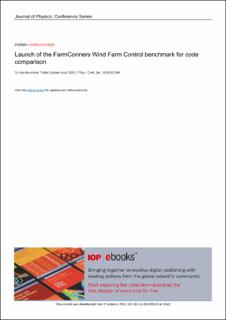| dc.contributor.author | Göcmen, Tuhfe | |
| dc.contributor.author | Kölle, Konstanze | |
| dc.contributor.author | Andersen, Søren Juhl | |
| dc.contributor.author | Eguinoa, Irene | |
| dc.contributor.author | Duc, Thomas | |
| dc.contributor.author | Campagnolo, Filippo | |
| dc.contributor.author | Iribas-Latour, Mikel | |
| dc.contributor.author | Astrain, David | |
| dc.contributor.author | Bottasso, Carlo | |
| dc.contributor.author | Meyers, Johan | |
| dc.contributor.author | van Wingerden, Jan Willem | |
| dc.contributor.author | Giebel, Gregor | |
| dc.date.accessioned | 2020-11-12T14:00:12Z | |
| dc.date.available | 2020-11-12T14:00:12Z | |
| dc.date.created | 2020-10-26T20:43:38Z | |
| dc.date.issued | 2020 | |
| dc.identifier.issn | 1742-6588 | |
| dc.identifier.uri | https://hdl.handle.net/11250/2687649 | |
| dc.description.abstract | Careful validation of the modelling and control actions is of vital importance to build confidence in the value of coordinated wind farm control (WFC). The efficiency of flow models applied to WFC should be evaluated to provide reliable assessment of the performance of WFC. In order to achieve that, FarmConners launches a common benchmark for code comparison to demonstrate the potential benefits of WFC, such as increased power production and mitigation of loads. The benchmark builds on available data sets from previous and ongoing campaigns: synthetic data from high-fidelity simulations, measurements from wind tunnel experiments, and field data from a real wind farm. The participating WFC models are first to be calibrated or trained using normal operation periods. For the blind test, both the axial induction and wake steering control approaches are included in the dataset and to be evaluated through the designed test cases. Three main test cases are specified, addressing the impact of WFC on single full wake, single partial wake, and multiple wake. The WFC model outcomes will be compared during the blind test phase, through power gain and wake loss reduction as well as alleviation of wake-added turbulence intensity and structural loads. The probabilistic validation will be based on the median and quartiles of the observations and WFC model predictions. Every benchmark participant will be involved in the final publication, where the comparison of different tools will be performed using the defined test cases. Instructions on how to participate are also provided on farmconners.readthedocs.io. | en_US |
| dc.language.iso | eng | en_US |
| dc.publisher | IoP | en_US |
| dc.rights | Navngivelse 4.0 Internasjonal | * |
| dc.rights.uri | http://creativecommons.org/licenses/by/4.0/deed.no | * |
| dc.title | Launch of the FarmConners Wind Farm Control benchmark for code comparison | en_US |
| dc.type | Peer reviewed | en_US |
| dc.type | Journal article | en_US |
| dc.description.version | publishedVersion | en_US |
| dc.rights.holder | The Authors | en_US |
| dc.source.volume | 1618 | en_US |
| dc.source.journal | Journal of Physics: Conference Series | en_US |
| dc.identifier.doi | 10.1088/1742-6596/1618/2/022040 | |
| dc.identifier.cristin | 1842452 | |
| dc.relation.project | EC/H2020/727477 | en_US |
| dc.relation.project | EC/H2020/727680 | en_US |
| dc.relation.project | EC/H2020/857844 | en_US |
| dc.source.articlenumber | 022040 | en_US |
| cristin.ispublished | true | |
| cristin.fulltext | original | |
| cristin.qualitycode | 1 | |

